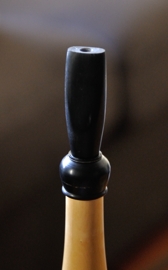PHILIPPE BOLTON
flageolets & recorders
A French flageolet after Prudent Noblet

Unlike the recorder, the flageolet did not fall into oblivion after the baroque period. It was played during the whole of the nineteenth century, and seems to have remained popular until about 1914.
This instrument is a copy of a fine boxwood French flageolet, made by Prudent Noblet around 1860. Like all similar instruments it has six holes, of which two are
thumb holes situated behind. The upper of these is used for playing high notes, as on the recorder. The two-piece conical windcap or flue has a beneficial effect on
the sound colour by forming a resonator above the windway. It probably helps to absorb condensation as well.
Click here for a XIXth century description of the windcap.
The flageolet is tuned in A, but for practical reasons its music is usually written as for an instrument in d.
This instrument is in boxwood. The mouthpiece and the ring on the bell are made from horn. The other rings on the original
are optional, since horn is more delicate than the wood itself.
|
|
|
A piano or echo key which enables playing softly without loss of intonation, like the one on the original, and the B♭ and E♭, keys which
are often found on XIXth century French flageolets are offered as optional extras.

a version with a piano key, like the original, in naturel coloured boxwood

a version in stained boxwood with a B♭ (D#) key on wooden posts, as on another original by Prudent Noblet
key on wooden posts, as on another original by Prudent Noblet

a version with two keys : B♭ and E♭
 D# & G# if the flageolet is used as a transposing instrument in D, as was common in the 19th century.
D# & G# if the flageolet is used as a transposing instrument in D, as was common in the 19th century.
(see fingering charts here.)

a five keyed version, with two trill keys (tone and semitone) and a "clé de sifflet" for playing high notes.

the horn mouthpiece
You can listen to this instrument here
Sul Margine,from
Jules Gard's Méthode Complète de Flageolet de Jules Gard (19th century)
The Following fingering charts are available:

